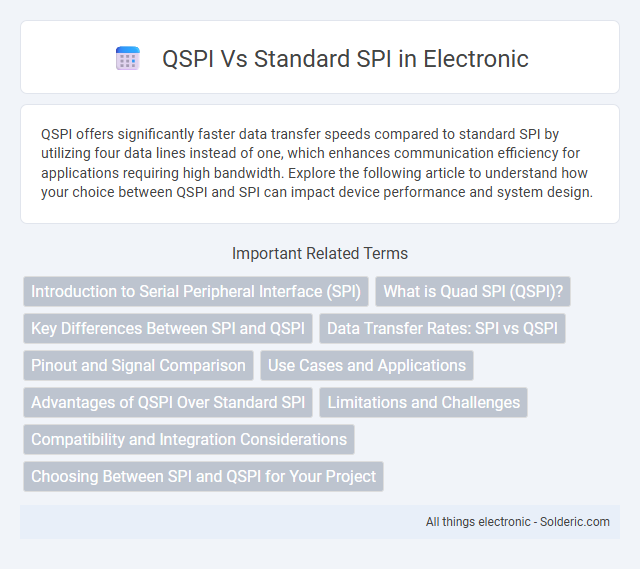QSPI offers significantly faster data transfer speeds compared to standard SPI by utilizing four data lines instead of one, which enhances communication efficiency for applications requiring high bandwidth. Explore the following article to understand how your choice between QSPI and SPI can impact device performance and system design.
Comparison Table
| Feature | QSPI (Quad SPI) | Standard SPI |
|---|---|---|
| Data Lines | 4 data lines (IO0-IO3) | 1 data line (MOSI) |
| Data Transfer Speed | Up to 4x faster than SPI | Standard speed, limited by single data line |
| Clock Frequency | Typically up to 100 MHz or higher | Typically up to 50 MHz |
| Complexity | Higher due to multiple data lines and control | Lower, simpler wiring and protocol |
| Common Use Case | High-speed flash memory access | General-purpose serial communication |
| Power Consumption | Typically higher, due to multiple lines switching | Lower power usage |
| Pin Count | More pins (usually 6-8 pins) | Fewer pins (usually 4-5 pins) |
| Protocol Compatibility | Backward compatible with standard SPI commands | Base protocol for QSPI |
Introduction to Serial Peripheral Interface (SPI)
Serial Peripheral Interface (SPI) is a synchronous serial communication protocol commonly used for short-distance data exchange between microcontrollers and peripheral devices. Standard SPI utilizes a single data line for transmission and reception, enabling full-duplex communication with clock synchronization and chip select control. Quad SPI (QSPI) enhances standard SPI by employing four data lines to increase data throughput, making it ideal for high-speed memory interfaces and faster data transfer applications.
What is Quad SPI (QSPI)?
Quad SPI (QSPI) is an advanced version of the standard Serial Peripheral Interface (SPI) that significantly enhances data transfer speeds by utilizing four data lines instead of one. QSPI enables faster communication between microcontrollers and external flash memory, making it ideal for applications requiring rapid read/write operations such as firmware updates or high-speed data logging. Your projects benefit from QSPI's ability to deliver up to four times the throughput compared to traditional SPI, optimizing performance for demanding embedded systems.
Key Differences Between SPI and QSPI
QSPI (Quad Serial Peripheral Interface) differs from standard SPI primarily in data transfer speed and bandwidth, as QSPI uses four data lines simultaneously compared to SPI's single data line. The multiple data lines in QSPI enable faster read and write operations, making it ideal for applications requiring high-speed memory access. Standard SPI is simpler with lower pin requirements, suitable for slower data transfer needs or basic peripheral communication.
Data Transfer Rates: SPI vs QSPI
QSPI (Quad SPI) offers significantly higher data transfer rates compared to standard SPI by utilizing four data lines simultaneously, enabling up to four times the throughput of traditional single-line SPI. Standard SPI typically transfers one bit per clock cycle, while QSPI can transfer four bits per cycle, which drastically reduces read and write latency in applications requiring fast memory access. Your choice between SPI and QSPI impacts overall system speed, especially in performance-critical embedded systems like flash memory or microcontrollers.
Pinout and Signal Comparison
QSPI (Quad SPI) significantly enhances data transfer speeds by utilizing four data lines (IO0 to IO3) compared to the single data line (MOSI) in standard SPI, while both share common pins like SCLK and CS. The increased pin count in QSPI allows simultaneous parallel data transmission, reducing clock cycles per byte and boosting throughput in flash memory operations. Your device's pinout must support these additional IO lines to fully benefit from QSPI's faster signal capabilities over traditional SPI interfaces.
Use Cases and Applications
QSPI excels in high-speed applications such as firmware storage, boot memory, and graphical displays where rapid data access is critical. Standard SPI remains suitable for simpler, lower-bandwidth use cases like sensor interfaces, small EEPROM memory, and basic communication between microcontrollers and peripherals. QSPI's quad data lines enable faster throughput, making it ideal for embedded systems requiring swift code execution and real-time data processing.
Advantages of QSPI Over Standard SPI
QSPI offers significantly faster data transfer rates compared to standard SPI by utilizing four data lines simultaneously instead of one, enhancing overall communication speed. This increased bandwidth makes QSPI ideal for applications requiring rapid memory access and high-speed data throughput, such as embedded systems and flash memory interfacing. Your system benefits from reduced latency and improved efficiency when opting for QSPI over standard SPI, especially in performance-critical environments.
Limitations and Challenges
QSPI faces limitations such as increased hardware complexity and higher pin count compared to standard SPI, complicating PCB design and increasing costs. The protocol's faster data transfer rates demand more stringent signal integrity measures and specialized firmware for effective operation. Standard SPI, while simpler and more universally supported, suffers from slower data rates and limited scalability, restricting its use in high-performance applications.
Compatibility and Integration Considerations
QSPI offers enhanced data transfer speeds by using four data lines compared to the single line in standard SPI, but it requires compatible hardware and firmware support to function properly. Standard SPI is widely supported and easier to integrate with existing microcontrollers and peripheral devices due to its simplicity and established protocols. When selecting between QSPI and standard SPI, your integration strategy should consider the compatibility of your system components and the availability of software drivers to ensure seamless operation.
Choosing Between SPI and QSPI for Your Project
QSPI offers significantly faster data transfer rates than standard SPI by using four data lines instead of one, making it ideal for high-performance applications requiring quick memory access. Standard SPI, with its simpler single data line, provides reliable and cost-effective communication suited for projects with lower speed demands or limited hardware complexity. Choosing between SPI and QSPI depends on your project's speed requirements, system complexity, and budget constraints, ensuring you select the best interface for optimal efficiency.
QSPI vs standard SPI Infographic

 solderic.com
solderic.com